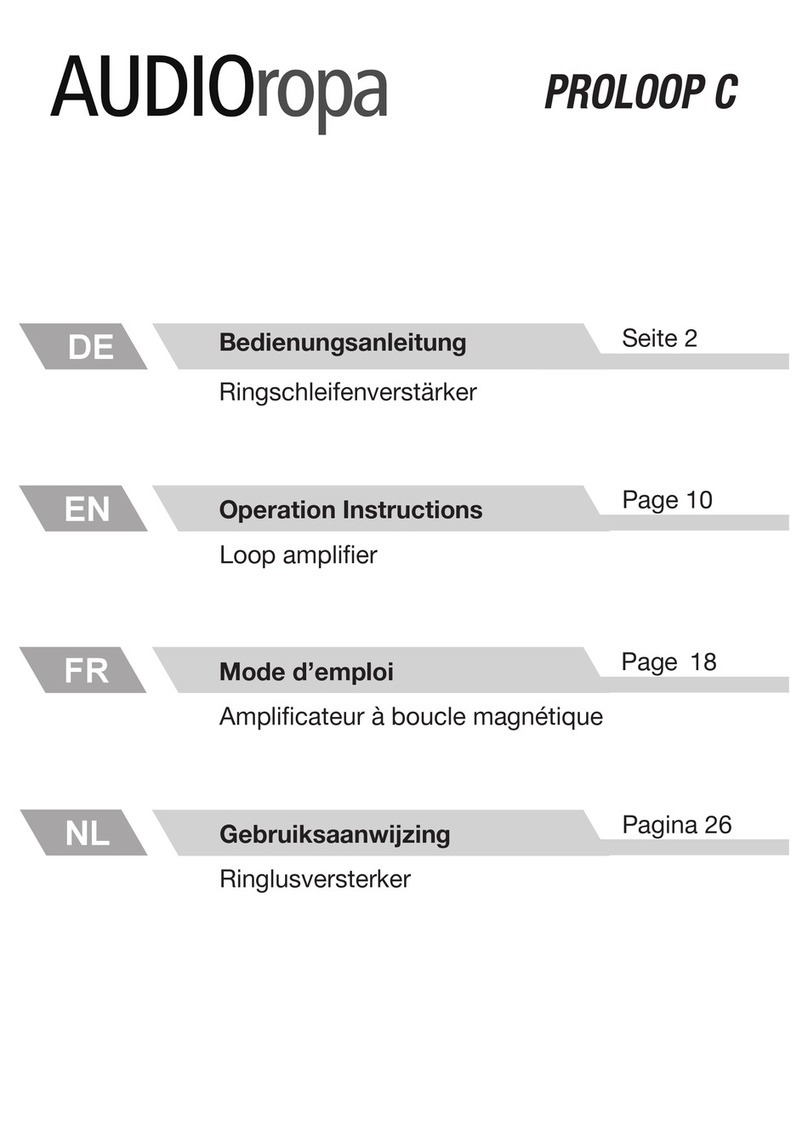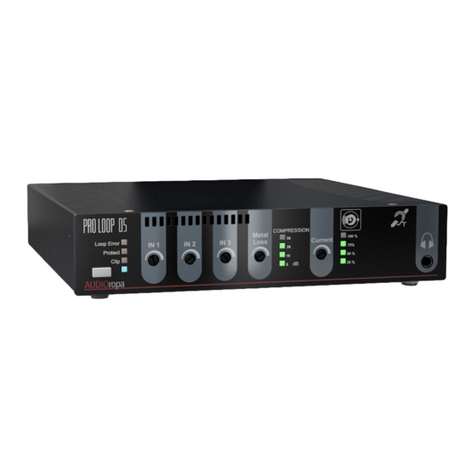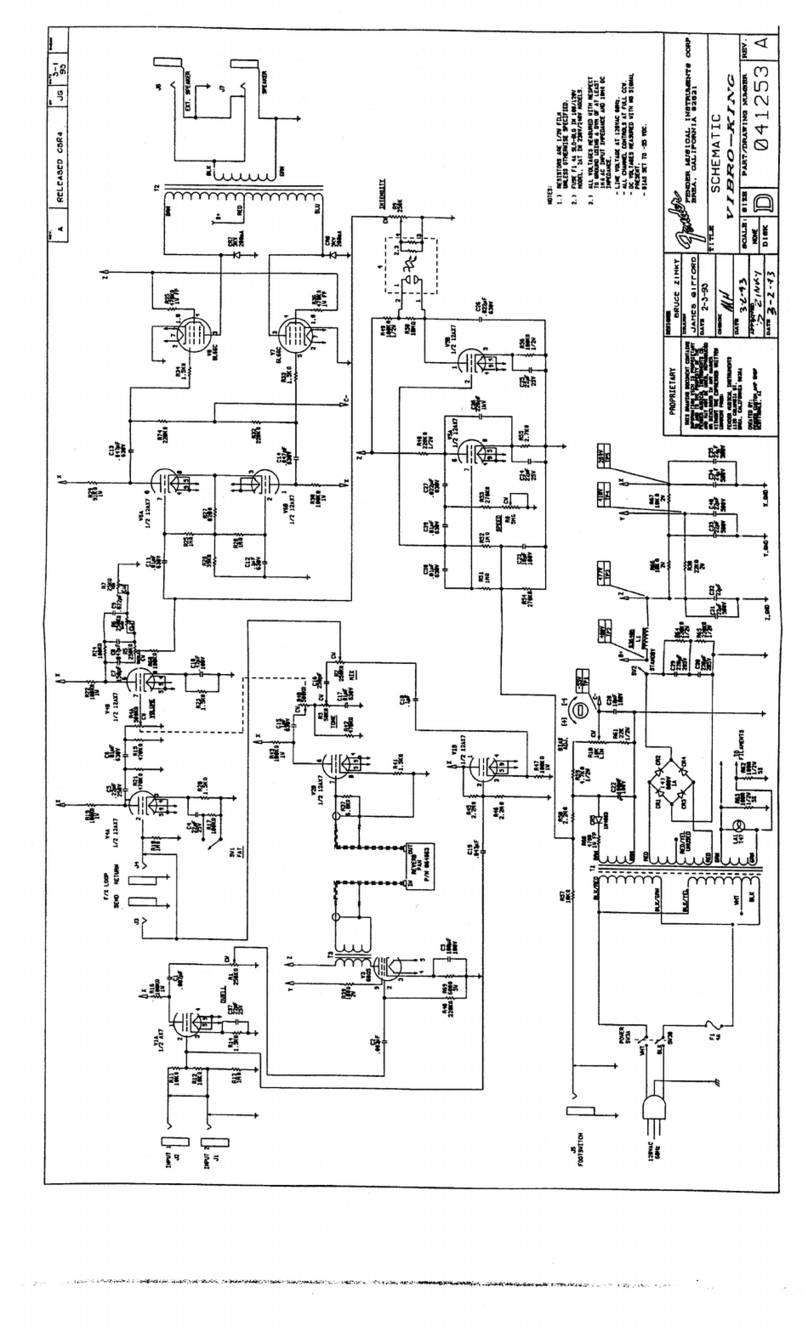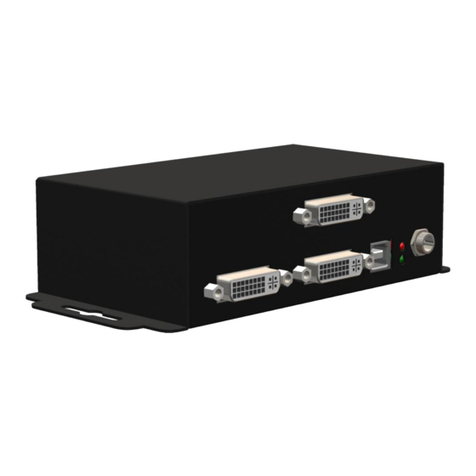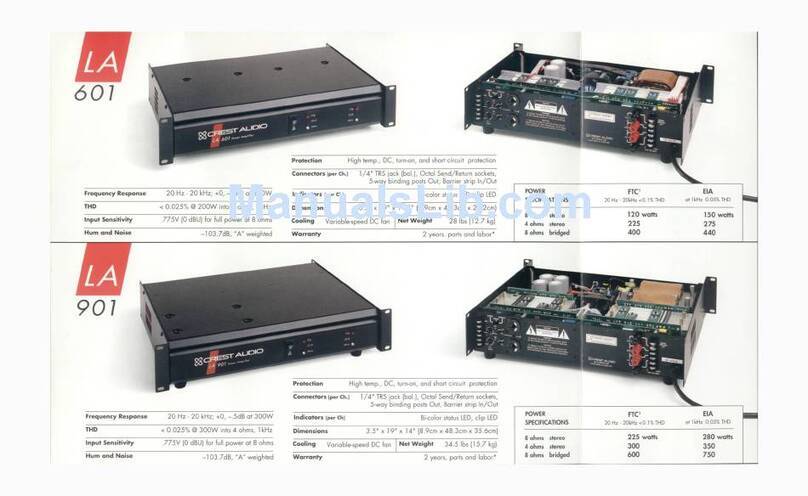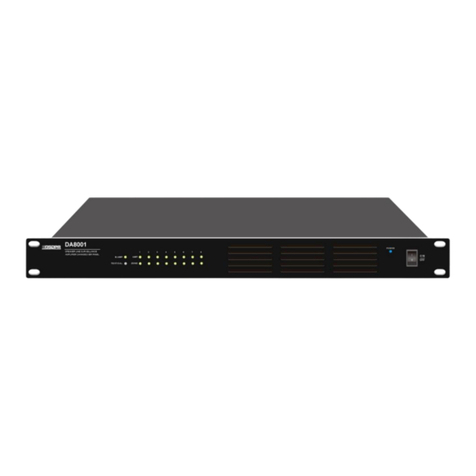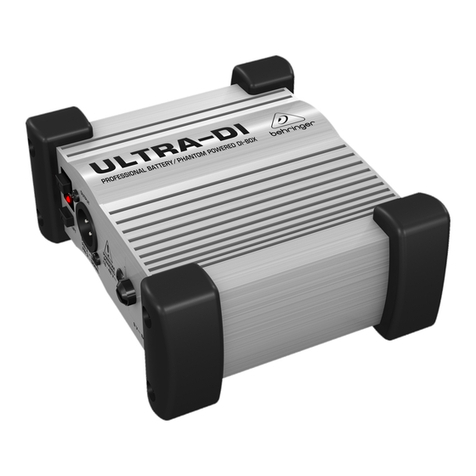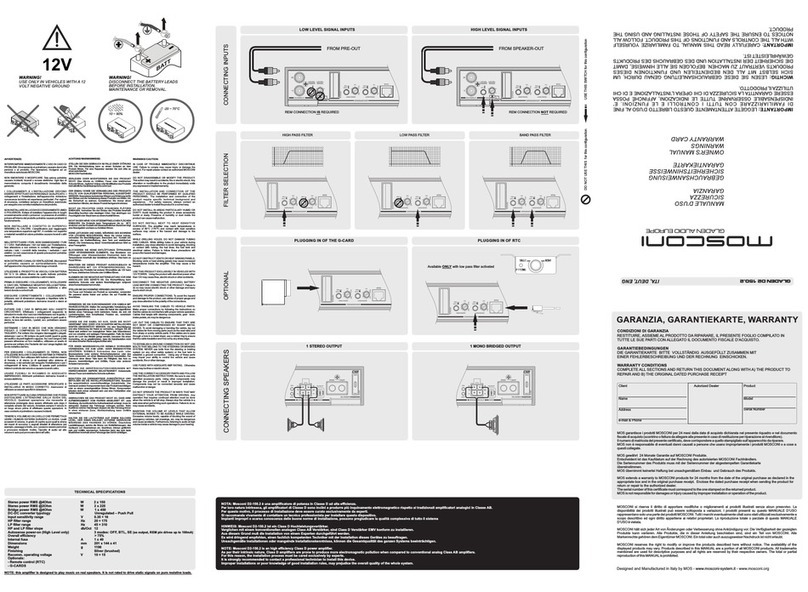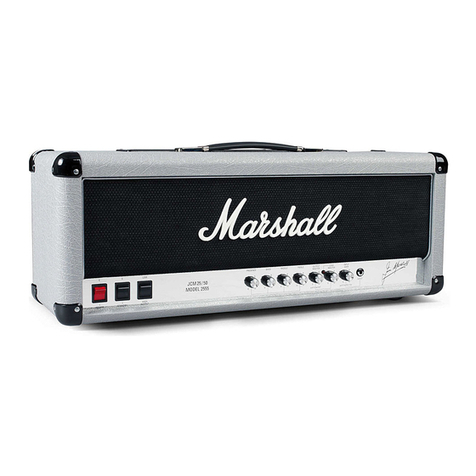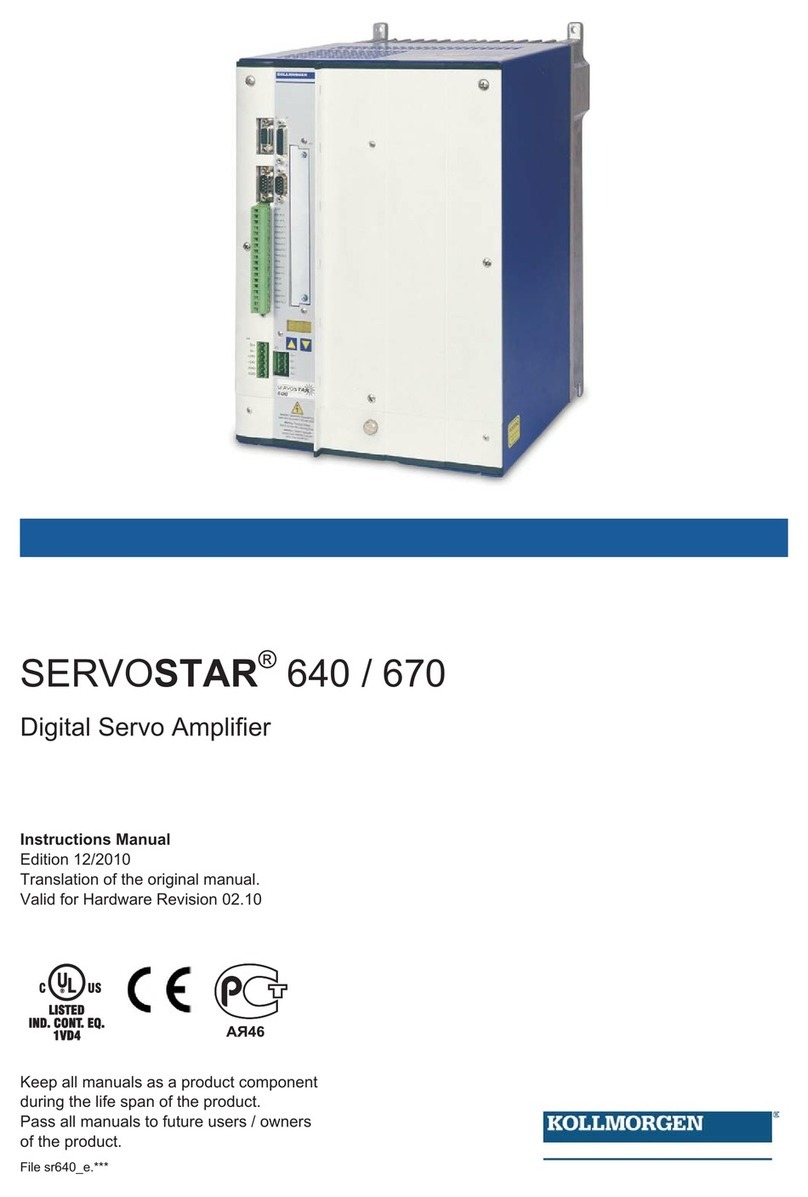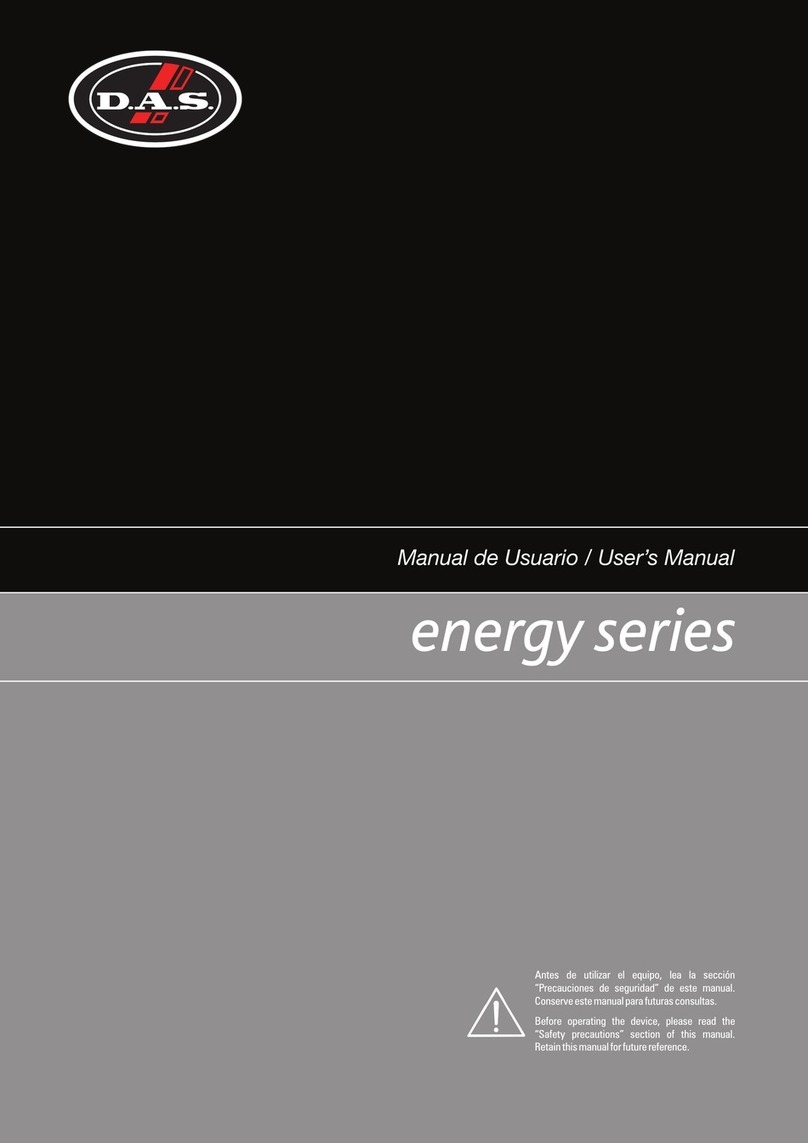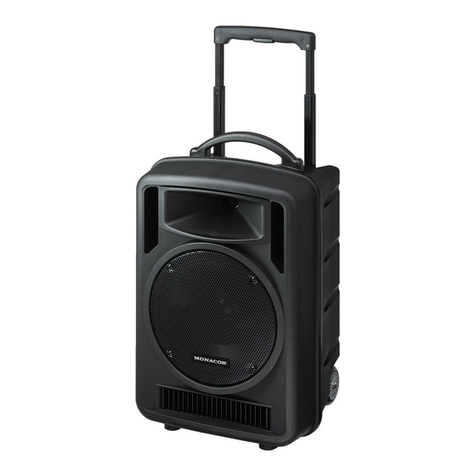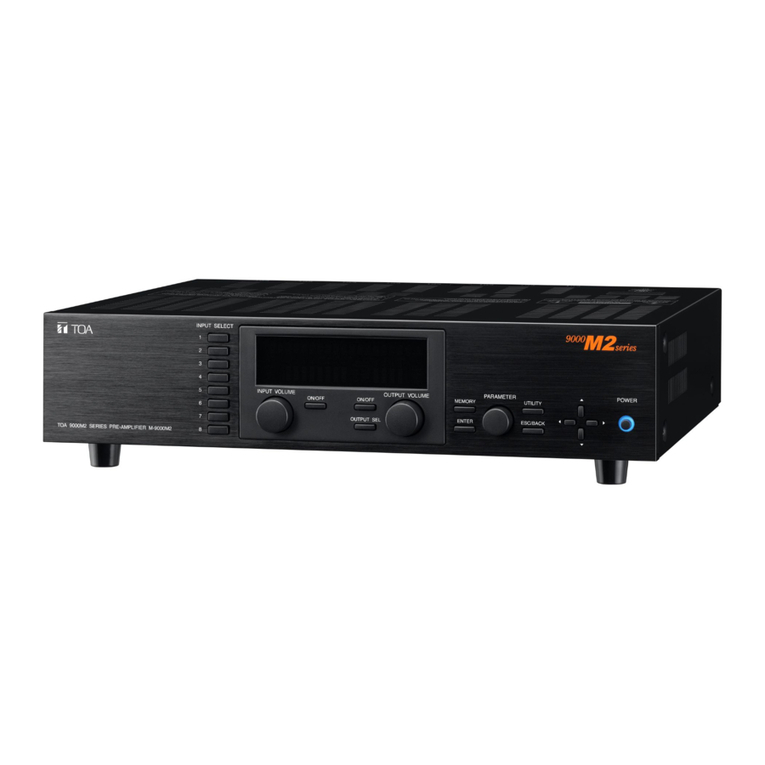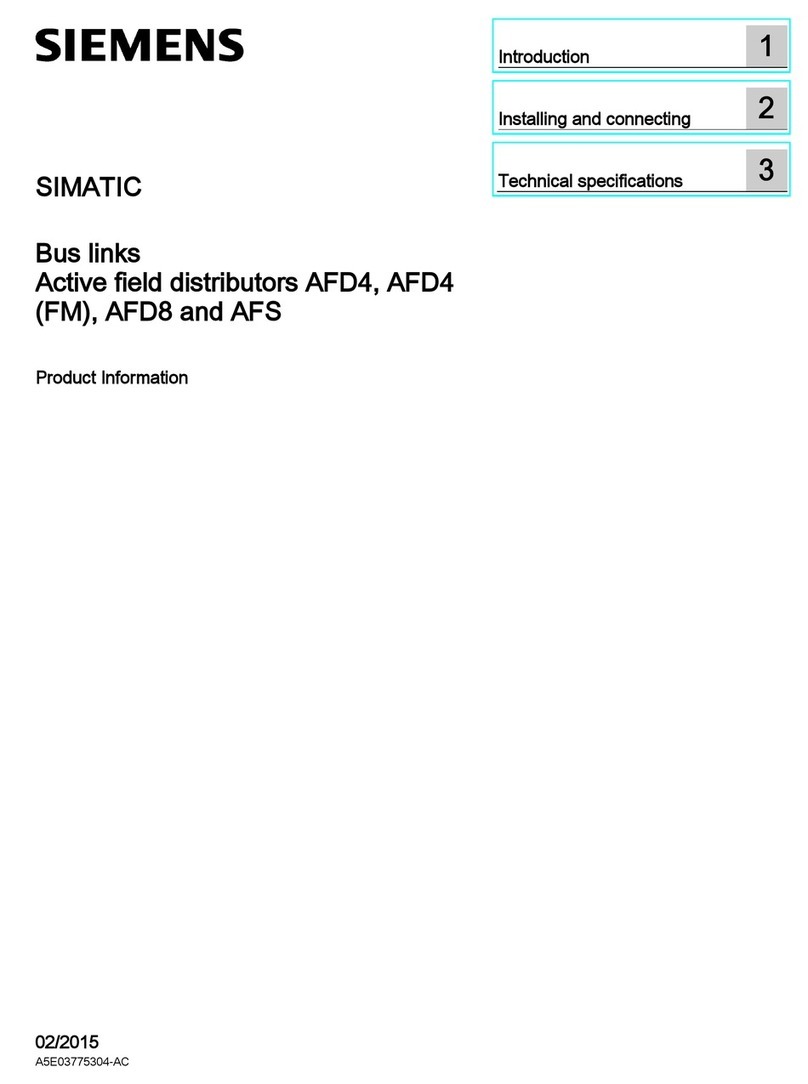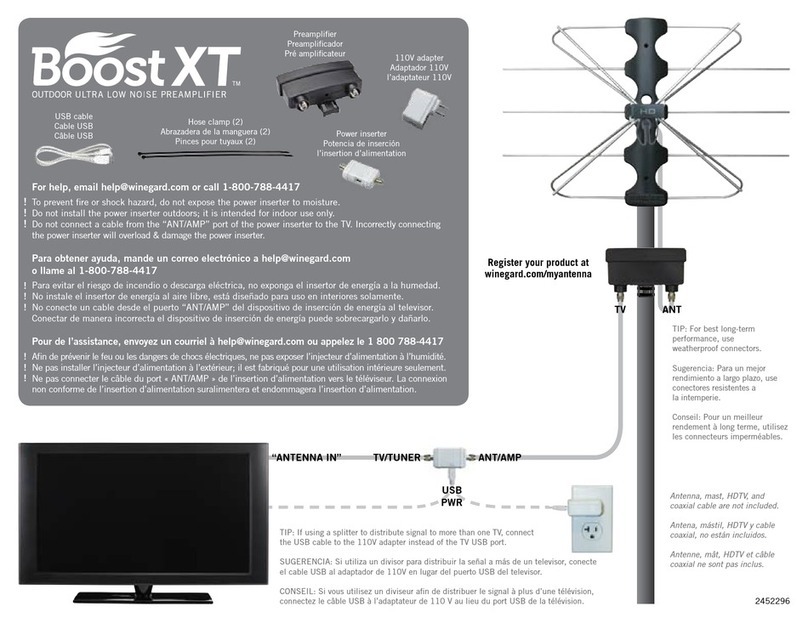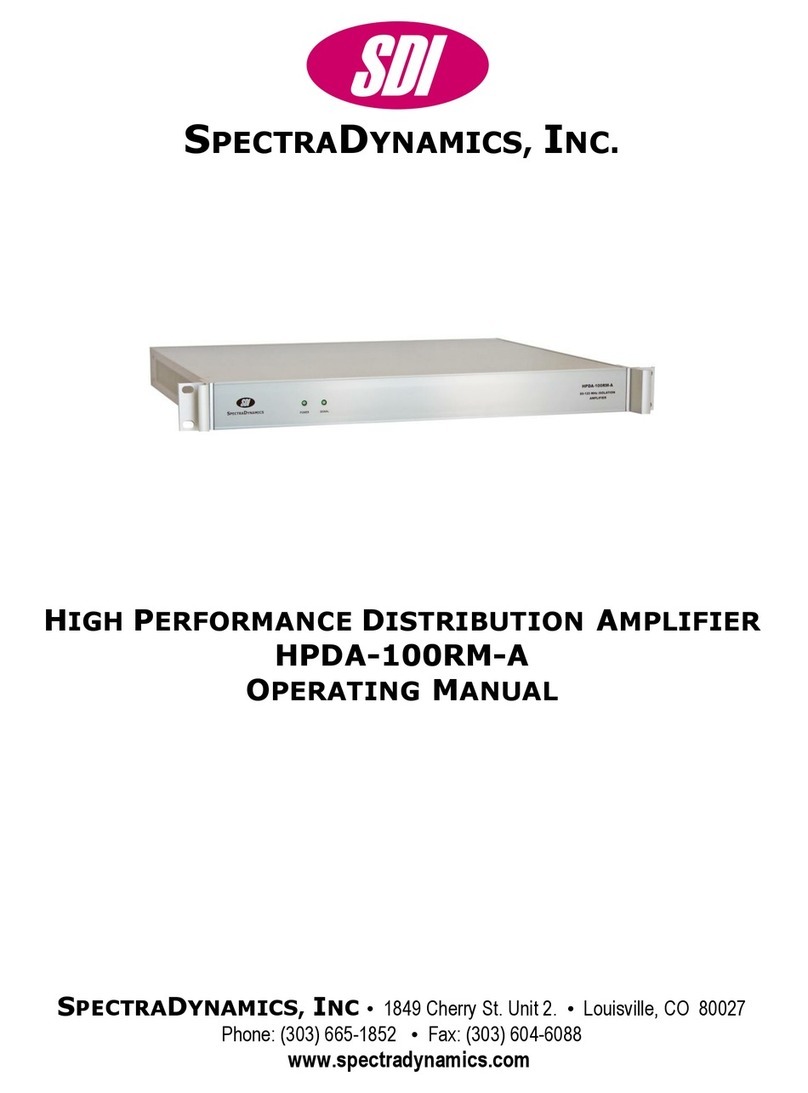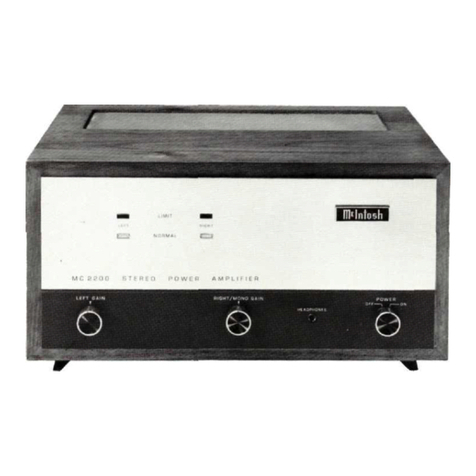AUDIOropa PRO LOOP DCCplus User manual


1.1 Front panel
(1) Power supply indicator
(2) VU indicator
(3) Level indicator for induction loop power
(4) Fault indicator
(5) ON/OFF Switch
(6) Regulator to set the corresponding
input sensitivity
(7) Bass control
(8) Treble control
(9) Loop integrity indicator
(10) Limiter indicator
(11) AGC indicator
(12) Power control
(13) Earphone jack
LOOP
230V AC
RoHS
conform
LINE OUT
PUSH IN
PUSH IN
115V AC
PHANTOM
ON OFF MIC LINE
PHANTOM
ON OFF MIC LINE
NC CNO
SUPERVISION
ON
OFF
MASTER IN
MASTER SLAVE
VU LED
PRE Amp. POST Amp.
SLAVE OUT
0° 90°
AGC
AGC LIMITER
10k 5k VOX
MIX
METAL LOSS
COMPENSATION
100V
0
PRIORITY
INPUT
OUT COM
12
Loop resistance
Min: 0.5
Max: 3.0
We would like to congratulate you on purchasing your new PROLOOP DCCplus induction loop amplifier. You
have chosen a product that skillfully combines appealing design with high technical performance.
This handbook describes exactly how the amplifier works and how it is to be used. Please read through the
operating instructions carefully before using the amplifier. We also reserve the right to make changes to incor-
porate new product developments at any time.
1. Overview of the connections and operating elements
1.2 Rear panel
(14) Fan outlet
(15) Fault output
(16) Supervision switch
(17) Line out
(18) Metal loss compensation
(19) Master/Slave connection sockets
(20) Voltage selector
(21) Power supply (110/230V / 50/60Hz)
(22) Priority input
(23) 10k/5k selection switch
(24) AGC/LIMITER Switch
(25) AGC control regulator
(26) MIX/VOX Switch
(27) Audio inputs
(28) Screw terminal for the connection of the loop
(29) Screw for earth connection
TREBLE
T
ON/OFF
LOOP
INTEGRITY
AGCLIMITER
0 dB-6 dB-12 dB
CURRENT
MAIN
FAULT
BASS
IN 1 IN 2
plus
14 English
1234
567812 13
910 11
14 15 16 17 18 19 20
22 23 24 25 26 27 28 29
21

English 15
1.1.1 Description of the indicators, controls and connectors at the front panel
(1) Power supply indicator: The green LED goes on if the induction loop amplifier is switched on.
(2) VU indicator: It shows the master VU level. 0 dB (red LED), -6 and -12 dB (yellow LED)
(3) Level indicator for induction loop power: It shows the electrical current throught the loop.
(4) Fault indicator: Shows a failed supervised function of the loop amplifier.
(5) ON/OFF Switch: The loop amplifier is switched on and off with this switch.
(6) Regulator to set the corresponding input sensitivity: Sets the input sensitivity of input IN1 and input IN2.
(7) Bass control: Controls the low tones of the audio signal.
(8) Treble control: Controls the high tones of the audio signal.
(9) Loop integrity indicator: The LED is on if the connected loop is not broken.
(10) Limiter indicator: The LED is on if the limiter is active.
(11) AGC indicator: The LED is on if the automatic gain control (AGC) is active.
(12) Power control: With this control you set the maximum electrical current of the induction loop.
(13) Earphone jack: You can connect headphones to the amplifier.
1.2.1 Description of the indicators, controls and connectors at the rear panel
(14) Fan outlet: Please do not cover it so that any heat generated by the device can be dissipated.
(15) Fault output: Gives the status of the loop amplifier to other equipment.
(16) Supervision switch: Switchs the supervision of the priority input on and off.
(17) Line out: Connection for a external recording unit.
(18) Metal loss compensation: Sets the metal loss compensation.
(19) Master/Slave connection sockets: Connect master and slave amplifiers to this amplifier.
(20) Voltage selector: Changes the voltage on which the amplifier should work.
(21) Power supply (110/230V / 50/60Hz): Connection for mains power supply.
(22) Priority input: Connection for systems which can override the audio signal on the induction loop.
For example a alarm system or a PA-system.
(23) 10k/5k selection switch: You can select the frequency range of the audio signal on the amplifier.
(24) AGC/LIMITER Switch: You can select the automatic gain control (AGC) or the limiter.
(25) AGC control regulator: Regulats the range of the automatic gain control.
(26) MIX/VOX Switch: Select if an audio signal of input 2 should override an audio signal of input 1 or if both
audio signals are mixed.
(27) Audio inputs: Connection for external audio sources.
(28) Screw terminal for the connection of the loop: The both ends of the loop cable will be connected here.
(29) Screw for earth connection: Connects the loop amplifier to earth.

1.3 What’s in the box
Please make sure that all the following parts are in the box:
•PROLOOP DCCplus induction loop amplifier
•Powercord
•Operatinginstructions
•“InductionListening”sticker
•Guaranteecard
If anything is missing, please contact your retailer or the manufacturer.
1.4. General information
The PROLOOP DCCplus amplifier has been designed for use in professional venues where high reliability and
safe operation are essential. The 100% short-circuit-proof amplifier with its extremely stable output power meets
these requirements.
1.5. How it works
The induction loop amplifier generates an alternating electromagnetic field around the loop cable. The loop con-
sists of an insulated wire, which is usually laid singly (or doubly) along the side of the room. When the hearing-
aidwearersetthehearingaidtothe“Tposition”,voltageisinducedintotheTcoil.Thisvoltagedependsonthe
amplifier’s input signal. Now the signals are amplified by the hearing aid and converted into sound. The alterna-
ting electromagnetic field inside the loop allows the hearing-aid wearer to move around freely in the room and to
receive the voice or music signals as high-quality, pleasant sound.
1.6. Notes on safe operation
This device complies with all the necessary EU directives and bears the CE seal of approval.
To make sure that your device enjoys a long service life, please observe the following information.
Important Information
To prevent accidents or personal injury caused by electrical shocks, never place any type of container
filled with a liquid, such as a vase, on the device.
Never pull on the power cord to remove the plug from the wall outlet; always grasp the plug directly
and pull it out.
Do not operate the device near heat sources or in rooms with high humidity (operating temperature
range 0-40°C).
Do not cover the air vents so that any heat generated by the device can be dissipated by air circulation.
Depending on how it is used, the device can develop high temperatures in the heat sink and at the air
vents. Be careful not to touch these elements by accident – risk of burns !!!
Do not use the device:
• if the power cord or the plug are defective or damaged.
• if the device is not functioning properly or is defective.
• if the device has been dropped or damaged in any other way.
To clean the device, simply wipe it with a soft, dry cloth – never use any kinds of chemicals or water.
Should a repair become necessary, have this done by an authorized technician only.
16 English

1.7 Supervision of the amplifier
The most essential functions of the inductive loop amplifier are supervised. The internal power amplifier, the in-
tegrity of the connected induction loop and the priority input is checked with a pilot tone by the induction loop
amplier.The“FAULT”-LEDonthefrontpanelwilllightupifasupervisedfunctionfailedandthefaultycontactis
out of power.
The supervision function can be switched off with the Supervision switch (16).
2. Installation
This device operates with a dangerous voltage of 110 V or 230 V. Never attempt to open the de-
vice yourself and never insert anything into the air vents! You could receive a severe electrical
shock!
Important notes
• Wheninstallingtheinductionloopamplier,makesurethattheairintakeatthetopandtheair
outlet at the back are not covered or blocked in any way.
• Itisnormalfortheampliertobecomewarmwheninoperation.Itisimportantthatairisableto
circulate freely around the device. If the air circulation is impeded in any way, the device will
require forced cooling.
• Makesurethattheamplierismountedsecurelyandwillnotsliporfall.
• Topreventanydamagetotheinternalcomponents,youshouldnotscrewscrewsordrillholes
in the device enclosure.
• Makesurethatthevoltageindicatedontherearsideofthedeviceisthesameasyourlocal
voltage.
• All connections should be made by a qualied technician only and only when the device is
switched off.
Tips
1. Before beginning to install the device, you should be sure to check the area for any magnetic
interference. Such interference can have a negative affect on the operation of the device or
make it impossible altogether. Interference can be caused by transformers, power lines, rein-
forced concrete or floor heating systems.
2. If the loop is to be installed in a pipe, then make sure that the pipe is made of plastic.
3. Do not lay any input signal cables parallel to the loop wire.
4. Avoid using dynamic microphones inside the loop. Always chose symmetrical electret or capa-
citor microphones to prevent acoustic feedback.
5. Ifitisnotpossibletolaytheloopinacircleorina“gure8”(doublecircle),thenaspecialloop
design calculated by an experienced technician will be necessary. (Please do not lay any comb
or meander structures!)
NC CNO
SUPERVISION
OFF ON
English 17

2.1 Cable cross section and wire diameter
The best audio quality can be reached if the DC (direct current) resistance of the induction loop is between 1
and 3 Ohm. The DC resistance depends on the wire diameter and the wire length. Please follow the steps
below:
1. Calculate the lenght of the loop wire. The wire lenght depends on the size of the induction loop.
2. Use the figure below to get the allowed wire diameter.
Example:
The wire lenght in a rectangular room with a width (W) of 10 m and a length (L) of 30 m is 80 m. According to
the figure below, the wire diameter must be between 0.77 and 1.34 mm. This corresponds to a cable-cross-
sectional area of 0.5 mm² and 1.5 mm².
You can use AWG 20 wire or a wire with a standard diameter of 1.00 mm (cable-cross-sectional area: 0.75 mm²).
Note
The inductive loop system works correct if the DC (direct current) resistance is between 0.5 ohm and
3 ohm.
2.2 Connecting the induction loop
Connect the ends of the loop wires to the terminals (28) on the rear of the amplifier.
Please note the following information
•Theloopampliermustbelocatedoutsideoftheloop.
•Twistthecablesectionbetweentheamplierandtheloop(feedcableto
the loop) to prevent interference.
•Useasuitablemeasurementdevice(e.g.ohmmeter)tomakesurethat
the loop doesn’t have a short-to-ground (no damage on the insulation of
the loop wiring)!
•Thedistancefromtheloopleveltothenormallisteninglevelshouldbe
approx. 1.20 m to 2.00 m.
18 English
LOOP
OUT COM

2.3 Configuring the amplifier and connecting audio sources
Up to 2 audio sources can be connected to the symmetrical XLR jacks (27).
Whenamicrophoneisconnected,theusedinputmustbeconguredwiththecorrespondingswitches(„MIC/
LINE“).Ifphantom-poweredmicrophonesareused,17Vofphantomvoltagecanalsobeadded.
Inthestandardconguration,inputIN1isconguredas“LineIN”andinputIN2as“microphone”withphan-
tom voltage. If you want to alter the standard setting please switch off the amplifier and set the switches on the
desired positions. After setting the switches please switch on the amplifier again.
2.4 Automatic Gain Control (AGC) / Limiter
2.4.1 General information
The automatic gain control (AGC) keeps the level of the audio signal on the connected induction loop constant.
The limiter makes sure that audio signals with a strenght of more than 0 dBV are not sent to the connected indu-
tion loop.
2.4.2 Switching the desired function on
Use the AGC/Limiter switch (24) to switch between AGC or Limiter function. If one function is set the other func-
tion is disabled.
AGC
AGC LIMITER
2.4.3 Setting the AGC range
You can set the AGC range with the AGC control regulator (25).
The correct AGC range depends on the audio input signals and the perceptions of the users of the connected
induction loop. If you set the AGC range too wide, soft sounds (e.g., undesired ambient noise) is amplified. If you
set the AGC range too narrow, desired soft sounds are lost.
2.5 Frequency range
You can set the frequency range with the 10K/5K switch (23).
To reach the most optimal results, set the switch on 5K position if the audio inputs contain speech.
If the audio inputs contain background music, set the switch on 10K position.
AGC
AGC LIMITER 10k 5k
English 19
PUSH IN1PUSH IN2
PHANTOM
ON OFF MIC LINE
PHANTOM
ON OFF MIC LINE
Microphone or Line IN (e.g.
CD-Player or audio amplifier)

20 English
2.6 Voice activation
The voice activation (VOX) of audio input 2 can be switched on and off with the MIX/VOX switch (26).
If the switch is set to VOX, audio signals of input 2 override the audio signals of input 1. The audio signals of input 1
and input 2 are mixed if the switch is set to MIX.
2.7 Using the priority input (22)
You can use the priority input to connect the induction loop amplifier with a alarm system or a PA-system. The
priority of the priority input is higher than the one of the audio inputs. The signal on the connected induction loop
is replaced with the signal of the priority input if a signal is received at the priority input. Please use the volume
control to set the volume of the audio signal which the priority input sends to the connected induction loop.
Important note
Put the safety bracket on the priority input to make sure that it is not possible
to touch the priority input.
2.8 Fault output
You can send the condition of the loop amplifier to an external devices (e.g. siren) with the voltage-free fault out-
put(15).Thefaultoutputisaninternalrelay.Normallyclosed“NC”isconnectedto“COM”bydefault.Therelay
connectsnormallyopen“NO”to“COM”ifasupervisedfunctionoftheampliferhasfailed.
2.9 Line output
You can connect a recording device (e.g., a tape deck) to the line output (17) of the loop amplifier.
2.10 Power supply (21)
The PROLOOP DCCplus induction loop amplifier can be used in countries with 110 V or 230 V mains power
supply.
To connect the amplifier with the mains power supply please do the following steps:
1. Set the voltage selector (20) to the correct position.
Position“115“forcountrieswith100to120V(AC)orPosition“230”forcountrieswith220to240V(AC).
Note
Thevoltageselectorisseton“230”positionwhenthePROLOOP DCCplus induction loop amplifier is
delivered.
VOXMIX
5k
10k
100V
0
PRIORITY
INPUT
NC CNO
LINE OUT

2. Please check if the fuse holder contains the correct fuse.
6Afuse(T)ifthevoltageselectorisseton“115”or
3Afuse(T)ifthevoltageselectorisseton“230”.
Note
A 3 A fuse (T) is set into the fuse holder when the PROLOOP DCCplus induction loop amplifier is
delivered.
3. Use a locally approved power cable to connect the loop amplifier to the mains socket.
2.11 First-time operation
Before you switch on the device, please turn all the control knobs as far to the left as possible.
- Connect a sound source to audio input 1.
- Connect the loop amplifier to the mains power supply.
- Set the AGC/Limiter switch on the Limiter position.
- Switch the audio source on.
- Switch the amplifier on. The indicator for the power supply (2) and the fault indicator (4) will light up during the
self-testing. After about 45 seconds the fault indicator light will go out and the amplifier is ready for use.
- Increase the volume of audio input 1 with its input volume control (6) until the Limiter LED lights up.
- Increase the electric current through the induction loop with the Power control (12) on the front of the amplifier.
- Use the earphone jack (13) to listen directly and, if necessary, adjust the sound with the bass (7) or treble (8)
control.
2.12 Adjusting the field strength
You will need a field strength gauge (special accessory) to calibrate the system correctly according to the
IEC 60118-4 standard.
2.13 Metal loss compensation
You will get a loss of the magnetic field strenght if you have strong reinforcement metal in the floor.
To compensat this loss use the metal loss compensation control on the rear side of the loop amplifier.
Please follow the steps below to set the metal loss compensation:
1. Turn the Metal loss compensation control to the left position.
2. Connect headphones to the headphone socket of the amplifier and listen to the audio signal.
3. Use an inductive loop receiver and the same headphones to listen to the audio signals of the inductive loop.
4. Turn the Metal loss compensation control to adjust the tone of the audio signal.
English 21
230V AC115V AC
IN 1 IN 2
MAIN
TREBLE
BASS

22 English
3 Setting up a LOS loop system with PROLOOP DCCplus
If you want to set up a LOS loop system you need two of the PROLOOP DCCplus. The first amplifier will be the
master unit and the second amplifier will be the slave unit.
3.1 Master and Slave configuration
- To define the first amplifier as Master amplifier the Master/Slave switch must be set on Master position.
- The second amplifier must be defined as Slave amplifier by setting the Master/Slave switch on Slave position.
Note
The slave amplifier can only send the signal that it receives from the master amplifier to its induction
loop. The audio inputs and the priority input of the slave amplifier are disabled.
3.2 LOS induction loops
The optimal designs and configurations are always dependent on the venue details, i.e. the floor plans and the
sizes of the rooms serviced, the number of internal induction loops and the demands made on low overspill.
To determine the corresponding values for the »tailored« low-overspill layout and the optimal level adjustments
in each case, it is necessary to use complicated calculation and installation methods. That’s why we recommend
that you use the services provided by HUMANTECHNIK. We support architects, technicians and installation ex-
perts qualified in the planning of LOS installations.
3.3 Installation of the induction loop
To use a LOS system, the induction loop must be installed in a special way. In detail, two separate loops are
used (master/slave), which consist of eight-piece segments lined up one after the other. The exact proportions
and the exact number of segments depend on the demands made on low overspill as well as the size of the
room. The smaller the segment, the smaller the overspill will be.
The master loop is laid over the entire area to be serviced. The slave loop is always one segment shorter than the
master loop and doesn’t begin until after the first segment half of the master loop. The individual segment lengths
should correspond to the distances between the seating rows.
We recommend using a single-strand cable, e.g. H07V-K or the copper ribbon cable (A-4937-0). Please refer
tosection“2.1Cablecrosssectionandwirediameter”fortheneededcablecrosssectionofthesingle-strand
cable.
3.4 Advantages of a LOS induction loop design
- No loss of field strength in the centre of the induction loop
- No horizontal overspill
- No signal holes inside the loop
MASTER SLAVE
VU LED
PRE Amp. POST Amp.

English 23
3.5 Example of a LOS loop measuring 16x19 metres, approx. 300m²
Fig. Example of a LOS loop
3.6 Connecting the induction loops to the master and slave amplifier
• Theloopampliershastobelocatedoutsideoftheloop.
• Connectthe90°SlaveOutofthemasterampliertotheMasterinsocketoftheslaveamplier.(Seepicture
below)
• Twistthesectionofcablebetweentheamplierandtheloop(supplytotheinductionloop)toreduceinterfe-
rence. (See picture below)
• Useasuitablemeasuringinstrument(e.g.ohmmeter)tomakesurethattheloopisnotgrounded(nodefectin
the insulation of the loop system). Typical resistance values for a 300m² loop lie between 0.5 and 3 ohms.
Since the master loop is longer, it also has a greater resistance.
• Connectthecableendsofthelooptothecorrespondingterminals(28)ontherearpaneloftheamplier.
Make sure that you do not mix up the ends of the master and the slave cable.
MASTER
LOOP
230V AC
RoHS
conform
LINE OUT
PUSH IN1PUSH IN2
115V AC
PHANTOM
ON OFF MIC LINE
PHANTOM
ON OFF MIC LINE
NC CNO
SUPERVISION
ON OFF
MASTER IN
MASTER SLAVE
VU LED
PRE Amp. POST Amp.
SLAVE OUT
0° 90°
AGC
AGC LIMITER 10k 5k
VOX MIX
META L LOSS
COMPENSATION
100V 0
PRIORITY
INPUT
OUT COM
MASTER IN
MASTER SLAVE
VU LED
PRE Amp. POST Amp.
SLAVE OUT
0° 90°
LOOP
230V AC
RoHS
conform
LINE OUT
PUSH IN1PUSH IN2
115V AC
PHANTOM
ON OFF MIC LINE
PHANTOM
ON OFF MIC LINE
NC CNO
SUPERVISION
ON OFF
MASTER IN
MASTER SLAVE
VU LED
PRE Amp. POST Amp.
SLAVE OUT
0° 90°
AGC
AGC LIMITER 10k 5k
VOX MIX
METAL LOSS
COMPENSATION
100V 0
PRIORITY
INPUT
OUT COM
MASTER IN
MASTER SLAVE
VU LED
PRE Amp. POST Amp.
SLAVE OUT
0° 90°
SLAVE
LOOP
OUT COM

24 English
3.7 Adjusting the amplifiers
In order to adjust a LOS system, you will require a field strength gauge, e.g. the FSMplus (A-4292-0).
1. Before you switch on the amplifiers, turn all the dials as far to the left as possible.
2. Plug in the power cords supplied with the amplifiers and switch the master amplifier on. The power supply
indicator (1) should now light up.
3. Before you adjust the line level, don’t forget to apply a test signal to the corresponding input. We recommend
using our test CD, which comes with the FSMplus (A-4292-0).
Use a 1kHz sine signal (track 3 on the CD) and set the volume control (master fader) on the mixing desk or
the audio amplifier as it is normally used at your events.
4. Adjust the input sensitivity regulator (6) of the LINE IN input used so that the control indicators (2) on the front
panel of the device lights up.
5. Turn the master power regulator (12) to the central setting. The control indicator (3) on the front panel should
now light up.
6.SettheFSMplusto“Norm”and“0dBscale”andholditverticallytotheinductionlooplevel.Theidealheight
depends on what the induction loop system is being used for; typically, this might be 1.20m (for seated au-
diences) or 1.70m (for standing audiences).
7. Check the average field strength by running diagonally over the induction loop area and determine the aver-
age of the values indicated. The average value has to measure 0dB (±3dB).
If you do not obtain this value, adjust the corresponding control until this value is reached. Please note that
every time you cross a cable, the field strength will drop briefly. This is normal as long as only one loop is in
operation.
8. Once the master amplifier is adjusted, switch off the master amplifier and disconnect the induction loop.
9. Now switch on the master and slave amplifier and set the slave amplifier up as discribed above.
Important: Do not alter any of the controls of the master amplifier.
11. If you have set up the slave amplifier, switch the master and slave amplifier off.
12. Re-connect the induction loop of the master amplifier.
13. Switch on the master and slave amplifer, again.
14. For the final check, use a normal audio signal, such as music or voice via the microphone and check the
field strength with the FSMplus. The value should read 0dB (±3dB) in the signal peaks.
If you do not read these values, repeat the measurement process starting from Step 3 and set the controls
higher than for the first test.
15. If the values lie within the stipulated range, the amplifiers are set to the ideal levels. Use the headphone jack
of the FSMplus to evaluate the sound of the signal with a pair of headphones.

English 25
4. Guarantee
The PROLOOP LOS induction loop amplifier exhibits very high operating safety. If any malfunctions should occur,
despite correct operation, please contact your retailer or the manufacturer. The guarantee covers repairs and
shipping free of charge. The device must be returned in its original packaging – do not discard it. The guarantee
becomes invalid if the device is operated incorrectly or any repairs are attempted by unauthorized persons (de-
vice seal is broken). Repairs will only be made on guarantee if you also include the correctly completed guaran-
tee card and a copy of the retailer’s invoice/receipt. The device number must always be included.
5. Environmental protection / disposal
Disposal of used electrical and electronic devices (applicable in EU countries and other European countries
with a separate collection system for these devices.) The symbol on the product or its packaging indicates that
this product should not be thrown into the regular household waste; it should be taken to a recycling centre for
electrical and electronic devices. When you dispose of this product correctly, you make a contribution towards
protecting the environment and your health. Incorrect disposal can pose a threat to the environment and your
health. Material recycling also helps to reduce the use of raw materials. Further information on recycling this pro-
duct is available from your community, the municipal waste disposal department or the retail outlet at which you
bought the product.
6. PROLOOP DCCplus specifications
Power supply 115 - 230 V AC, 50Hz, 7- 400 W
Coverage 600 m² acc. to IEC 60118-4
Induction loop output
Max. power 10 A RMS, continuous 1 kHz, short-circuit-proof
Frequency range 100 – 5000 Hz (±3 dB)
Distortion < 1 %
Cable connection 2 screw connections on the rear panel of the device
Outputs
LINE OUT XLR-plug, nominal level: 1V
Headphone jack 6,3 mm
SlaveOut 0°phaseshift(6,3mmjack)
SlaveOut 90°phaseshift(6,3mmjack)
Inputs
IN 1 and 2 XLR-3 connector, optionally LINE-in (symmetric, sensitivity: 1V) or
Microphone-in (asymmetric, sensitivity: 1mV)
Amplification adjustment, phantom current 17V can be added
Input priorities: VOX-voice control, IN2 mutes IN1.
100V-priority input, for connection to a PA-System
Controls and regulators
Treble adjustment -8 up to +8 dB by control dial
Bass adjustment -8 up to +8 dB by control dial
Loop current adjustment by control dial
Amplification adjustment for IN 1 and IN 2 by dial
Indicators
Power supply 1 green LED
Input level 2 yellow LEDs and 1 red LED
Induction loop current 4 green LEDs and 1 red LED
Induction loop monitor One 6.3-mm jacks to connect headphones
Dimensions 90 x 430 x 270 mm (H x W x D)
Colour Black
Weight 6,5 kg

NL
Netherlands
Tel.: +31 (0) 3 45/ 63 23 93
Fax: +31 (0) 3 45/ 63 29 19
E-mail: info@hoorexpert.nl
AUDIOropa Service-Partner
D
F/B
CH
For other service-partners
in Europe please contact:
Humantechnik Germany
Tel.: +49 (0) 76 21/ 9 56 89-0
Fax: +49 (0) 76 21/ 9 56 89-70
Internet: www.humantechnik.com
E-mail: [email protected]
France
Belgium
Switzerland
Germany
Tel.: +49 (0) 76 21/ 9 56 89-0
Fax: +49 (0) 76 21/ 9 56 89-70
E-mail: [email protected]
Tel.: +41 (0) 61/ 6 93 22 60
Fax: +41 (0) 61/ 6 93 22 61
E-mail: [email protected]
Tel.: +33 (0) 3 89/ 44 14 00
Fax: +33 (0) 3 89/ 44 62 13
E-mail: sms@audiofr.com
Hoorexpert BV
Gildenstraat 30
NL-4143 HS Leerdam
Humantechnik GmbH
Im Wörth 25
D-79576 Weil am Rhein
Humantechnik GHL AG
Rastatterstrasse 9
CH-4057 Basel
SMS
Audio Electronique Sàrl
173 rue du Général de Gaulle
F-68440 Habsheim
GB
Great Britain
Tel.: +44 (0) 16 42/ 24 77 89
Fax: +44 (0) 16 42/ 23 08 27
E-mail: [email protected]
Sarabec Ltd
15 High Force Road
GB-Middlesbrough TS2 1RH
... a Division of the Humantechnik Group
RM426400 · 1012
Table of contents
Other AUDIOropa Amplifier manuals
